Hamarikyu Gardens, Tokyo
Hamarikyu Gardens are Tokyo's largest traditional landscape garden and one of the most famous and visited. It is the only landscaped garden in the city located in front of the sea, near the mouth of the Sumida River. The garden is surrounded by water on all four sides. Along three of these there are canals, which once had the purpose of protecting the feudal lords who lived there. A fourth side directly faces Tokyo Bay. The skyscrapers of
Shiodome stand out behind the garden.
Practical information, hours and fees
Admission:: 300¥, over 65: 150¥
Opening hours: 9:00-17:00
Closing days: From 29 December to 1 January
Other useful information: free guided tours of the gardens are organized on weekends and occasionally on other days (
more information)
All the details on Hamarikyu Gardens
Historical background
Hamarikyu Gardens were originally built as the residence of a feudal lord during the Edo period in 1654. In 1709 it became the mansion of the Tokugawa shogun family and for a period also served as a branch of
Edo Castle (where the current
Imperial Palace is located) and also as a duck hunting ground. The garden was remodeled almost as we see it today during the era of Ienari Tokugawa (1787-1837). During the Meiji period (1868-1912) it became an imperial villa, often used by the emperor to entertain foreign guests. After the World War, the garden was finally donated to the local Tokyo government and became a public park. Traces of this colorful past can still be seen throughout the garden.
Shiori Pond
Shioiri Pond is the center of beautiful scenery with the long Otsutai Bridge, small islands, the tea house, and skyscrapers in the background reflecting in the pond water. The pond draws seawater from Tokyo Bay through a system of locks that open and close as sea level rises and falls, regulating the flow of water in and out of the pond. Visitors can thus observe different scenarios around the pond depending on the tide level. The pond is home to marine fish, while on the shores you can find crabs and sea beetles.
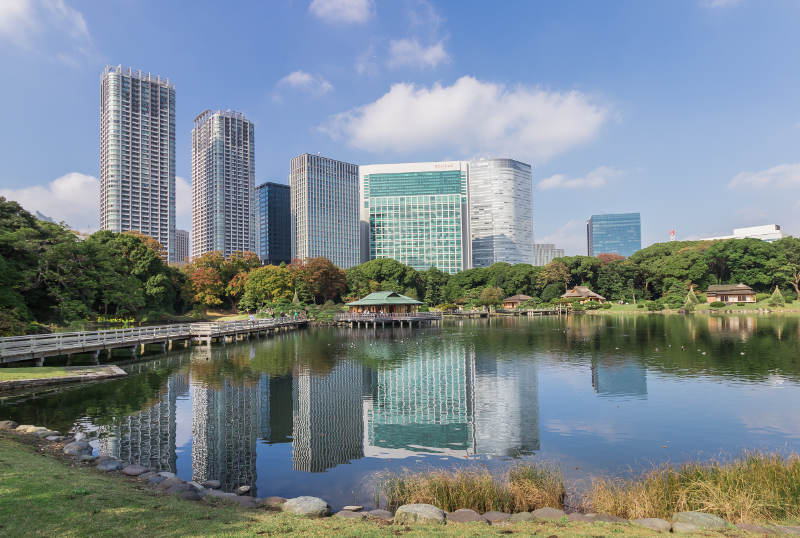 the typical view of the Shiori Pond, the Nakajima tea house and the skyscrapers of Shiodome
the typical view of the Shiori Pond, the Nakajima tea house and the skyscrapers of Shiodome
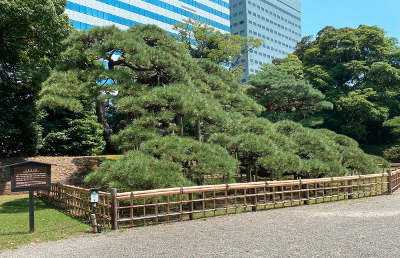
300 year old pine
This pine tree was planted in 1709 by the sixth shogun, Ienobu Tokugawa, to commemorate the remodeling of the gardens. It is one of the largest black pines in Tokyo, with thick branches extending downwards. It is located a few meters from the main Otemon entrance, on the left.
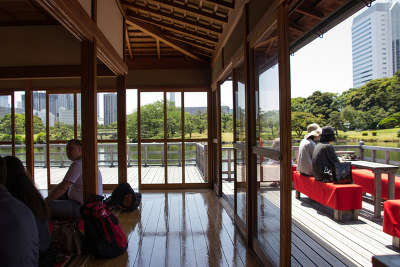
Nakajima No Ochaya Teahouse and others
There were once five tea houses in Hamarikyu Gardens, but all were destroyed during the great earthquake of 1923 or during World War II. The Nakajima no Ochaya teahouse was restored in 1983 and has been open to the public and in business for years. Here you can enjoy a cup of green tea and a Japanese dessert for 510 yen¥ with a wonderful pond view and atmosphere. This tea house is the only one located on an islet in the center of Shiori Pond. Unfortunately, sometimes so much wonder is disturbed by too many tourists.
Three other tea houses were rebuilt in the 2010s as monuments, namely Matsu no Chaya (2010), Tsubame no Chaya (2014), and Taka no Ochaya (2017). All three are located along the banks of the Shiori Pond.
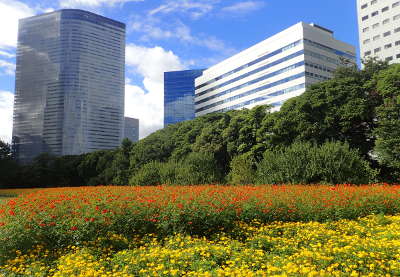
Trees and flowers
In the northern part of the park, not far from the main entrance, there is a large field of flowers which in the months of March and April is tinged with yellow thanks to the flowering of rapeseed flowers, and in summer is tinged with many colors thanks to the yellow cosmos flowers that bloom at the end of July, while the pink, white and purple cosmos flowers bloom in September. Not far from here, there is a peony garden (flowering between April and May) and a series of plum trees (flowering from the end of February). In addition, although the park is not particularly famous for cherry blossom or for the fall of winter leaves, there are still several cherry trees, as well as maple, ginkgo and other trees that show the typical autumn colors between the end of November and early December.
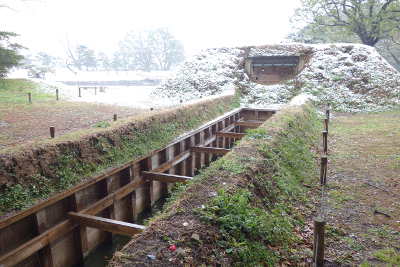
Ponds for duck hunting
Within these gardens there are two different ponds that were once used by shoguns for hunting ducks. One is located in the center of the gardens and is called Koshin-do kamoba (1778), another is in the west corner and is called Shinsen-za kamoba ( 1791). At the center of each of these ponds there is a small flat island, densely vegetated and ideal for nesting. The water around the island protects the birds from predators and there are thickets of evergreen trees and bamboo canes on all shores. Near the Koshin-do, huts used for hunting have survived until today, and they are the only evidence of this type survived in Japan till today. This "just for fun" hunting activity continued until 1944. In 1935 a memorial was erected to remember all the ducks that lost their lives on these hunting grounds.
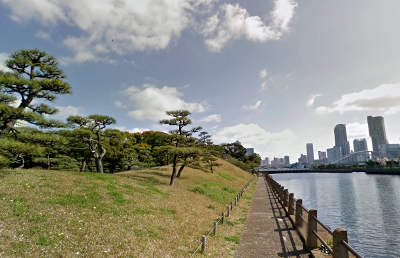
Waterfront
These gardens are the only seaside gardens from the Edo period that have survived to this day. One of the four sides of the park overlooks Tokyo Bay and is full of benches to relax on while enjoying the sea breeze, although the view of the sea is interrupted by an external embankment protecting the park. Inside there is also a pier that serves as a stop for a line of boats that connects the gardens with Asakusa.
How to get to Hamarikyu Gardens
Hamarikyu Gardens are located next to the skyscrapers of
Shiodome, and just south of the
Tsukiji area. The paths to reach these gardens from the nearest stations are a bit tortuous, because you have to somehow go to the other side of a series of high-speed roads that cannot be crossed directly and that considerably lengthen the path compared to the distance as the crow flies.
Entrance gates to the Hamarikyu Gardens
There are two entrances to Hamarikyu Gardens:
- The main entrance is located in the northern part of the park and is known as Otemon Gat , which is accessed after crossing an impressive stone bridge. The nearest stations are Tsukijishijo (600 metres) and Shimbashi (1.2 km).
- A secondary entrance, the Nakanogomon gate, is located on the west side of the park and is the closest to Shiodome station (1 km).
Getting to Hamarikyu Gardens by boat
Inside the gardens there is also a pier that serves as a stop for the tourist boats of
Tokyo Cruise. You can reach the gardens by boat from Asakusa (35 minutes, 1040 ¥: one way including the entrance to the garden).
Map of Hamarikyu Gardens, Tokyo
Guided tours, activities and other things to do
If you are planning a trip to Japan and you want to do something more than just visiting famous places and monuments, we suggest you to use
Rakuten Travel Experiences.
How to use Rakuten Travel Experiences
Rakuten Travel is a very useful website to
enrich your travel experience, especially if you are going solo or it's your first time in Japan.
Because of the language barrier (and more), in Japan it is very difficult to interact with the locals and to get off the tourist track.
Thanks to Rakuten Travel you can find a lot of interesting and sometimes unique
guided tours and activities all over Japan (and not only in Japan), that you would otherwise never be able to enjoy.
But there's more: on Rakuten Travel you can also
buy tickets for several famous attractions, events, transportation and other useful services for tourists. Last but not least, you can
reserve a table in hundreds of restaurants.
Some examples
Take a look at Rakuten Travel Experiences
You may also be interested in




